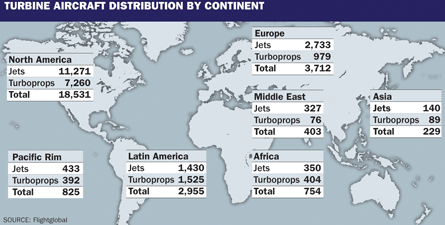Despite the economic gloom the global corporate aircraft fleet has grown in every continent over the census period, Flightglobal's ACAS database reveals, with emerging markets and most of the traditional markets making significant gains.
Asia has recorded the strongest fleet growth in the census period - albeit from a small installed base. According to ACAS, the fleet climbed from 199 in the previous report to 229 this year. While Nepal makes its census debut with one turboprop, Asian growth is solely attributable to the booming Indian market where the clamour for business aircraft continues at a relentless pace. The country's expanding middle classes and its plethora of millionaires have helped India's turbine inventory to increase by 31, to 193 turbine-powered business aircraft - which represents 84% of the region's business jet and turboprop fleet.
Despite being at the forefront of the economic hurricane, Europe's fleet - the second-largest business aircraft inventory in the world - has climbed by 13% to 3,712 jets and turboprops. The Isle of Man - a UK Crown Dependency - has witnessed the most dramatic growth within the region. The lure of its tax haven status to the global business aviation community has helped to boost its inventory in the past 12 months from 11 to 29 corporate jets.
Similarly, the lure of the Austrian and Swiss registers has pushed up fleet numbers in these countries by 39 and 22 jets and turboprops respectively since the 2008 census. Russia - previously the darling of the business aviation manufacturing community - has seen a modest rise in its inventory from 208 to 226 aircraft. While there remains a cluster of high net-worth individuals in Russia willing to buy aircraft, the market crash last year wiped billions off the fortunes of many of the country's wealthy individuals, leading to a dramatic decline in sales of new business aircraft. This is particularly acute at the top end of the market - hitting sales of Boeing Business Jets, Dasault Falcons and Gulfstreams. Meanwhile, Russian-made aircraft including Ilyushin Il-76s, Tupolev Tu-134s and Tu-154s and Yakovlev Yak-42s are becoming increasingly popular for domestic business flights, with each type making fleet gains of four, three, five and 11, respectively.
 |
|---|
The Middle East fleet continues to expand, jumping by more than 12% to 403 aircraft - 326 jets and 76 turboprops - since the last census. With the exception of Jordan, Kuwait and Syria - where the inventories remain unchanged - the region's other territories have seen fleet gains. Saudi Arabia continues to top the leader board with 121 aircraft - 15 more than last year, while the United Arab Emirates has witnessed the sharpest growth. Here the inventory has climbed by more than 25% from to 94 aircraft, spurred by the region's booming charter market.
The Pacific Rim is also gaining ground. This year's listing shows the fleet grew by more than 7%, from 769 to 825 jets and turboprops. Wallis and Futuna Island makes its census debut with two turboprops, while the Philippines' installed base has climbed by an impressive 21 turbine types.
Malaysia has seen its fleet climb by 30% to 25 jets and 14 turboprops as the acceptance of business aircraft in the country gains momentum. The regeneration last year of Kuala Lumpur's Subang Skypark airport into a business aviation hub for the region has helped to boost numbers.
China has witnessed a modest climb of 28 aircraft across its territories including Hong Kong and Macau, but this country continues to offer a wealth of opportunity for manufacturers. The government continues to make strides to improve the infrastructure and regulatory environment, but growth is slow.
Japan continues to see its corporate fleet tally decline - this year by 25 aircraft - with turboprop numbers plummeting by more than 35% to 74 aircraft. The country's refusal to endorse business aviation holds back the market, despite attempts to ease regulation and allow access for business aircraft to Tokyo's major airports. But Australia is proving fertile territory for business aircraft manufacturers. This year the fleet has risen by nearly 5% to one jet and 162 turboprops.
Latin America - home to the third-largest installed base - continues to embrace business aviation as this year's listing reveals. Here the turbine fleet has risen by 9% to 2,955 - a climb of 235 jets and turboprops. Africa and Latin America are the only two places where the turboprop fleet outnumbers the jet inventory, driven by a need to access remote areas. Brazil has overtaken Mexico this year as home of the largest installed base of corporate aircraft. Itss fleet has climbed by 113 aircraft to 417 jets and 447 turboprops - representing the largest concentration of turboprops outside Canada and the USA. Mexico is snapping at its heels, boasting a corporate inventory of 822 jets and turboprops - a climb of 33 jets and 16 turboprops during the census period.
Elsewhere in the region Argentina, Chile and Venezuela continue to make significant fleet gains of 10, 10 and 18 aircraft respectively, driven by a thriving economy.
While Canada and the USA continue to dominate the world's turbine fleet, overall inventory has only nudged ahead by just over 2% since the last census, to 18,531 aircraft. Canada saw its fleet numbers climb by 24 aircraft to 913 jets and turboprops, while the USA, which accounts for the bulk of the inventory with 17,618 aircraft has grown its fleet by 238 turbine aircraft.
This brittle territory has been crippled by the financial crisis, leaving many aircraft owners and position holders to abandon their assets. The continent has subsequently also become a low sales priority for traditional airframers and it is unclear how soon consumer confidence will be restored.
Source: Flight International



















